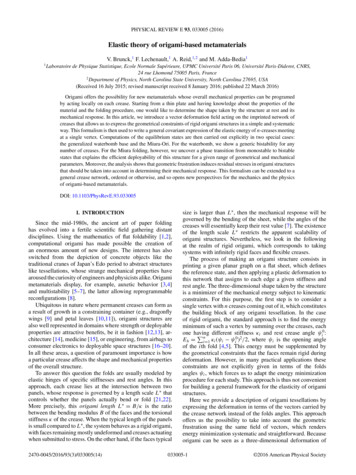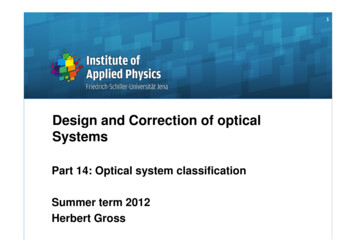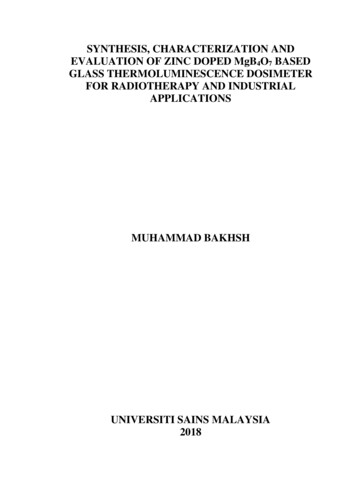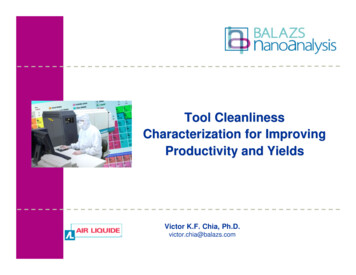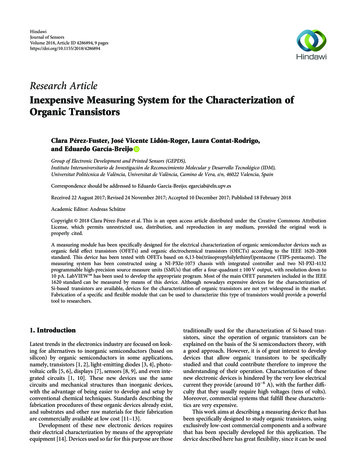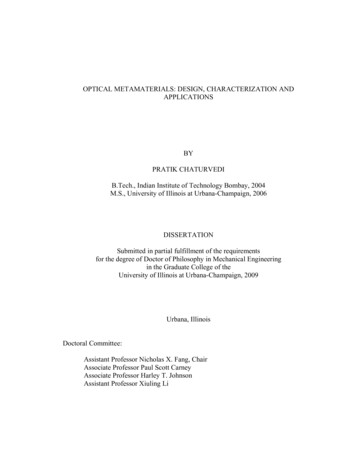
Transcription
OPTICAL METAMATERIALS: DESIGN, CHARACTERIZATION ANDAPPLICATIONSBYPRATIK CHATURVEDIB.Tech., Indian Institute of Technology Bombay, 2004M.S., University of Illinois at Urbana-Champaign, 2006DISSERTATIONSubmitted in partial fulfillment of the requirementsfor the degree of Doctor of Philosophy in Mechanical Engineeringin the Graduate College of theUniversity of Illinois at Urbana-Champaign, 2009Urbana, IllinoisDoctoral Committee:Assistant Professor Nicholas X. Fang, ChairAssociate Professor Paul Scott CarneyAssociate Professor Harley T. JohnsonAssistant Professor Xiuling Li
ABSTRACTArtificially engineered metamaterials have emerged with properties andfunctionalities previously unattainable in natural materials. The scientific breakthroughsmade in this new class of electromagnetic materials are closely linked with progress indeveloping physics-driven design, novel fabrication and characterization methods. Theintricate behavior of these novel metamaterials is interesting from both fundamental andpractical point of view. New frontiers are being explored as intrinsic limitations challengethe scaling of microwave metamaterial designs to optical frequencies. These materialspromise an entire new generation of miniaturized passive and active optical elements. Inthis study, I demonstrate an on-fiber integrated “fishnet” metamaterial modulator fortelecommunication applications. This metamaterial shows remarkable coupling to fiberguided modes (3.5dB) and a photoswitchable tuning range of more than 1.8dB. Thedesign offers extremely small footprint ( 10 wavelengths) and complete elimination ofbulk optical components to realize low-cost, potential high-speed optical switching andmodulation.Unique characterization techniques need to be developed as conventional opticalmicroscopy runs out of steam to resolve the fine features of optical metamaterials. Toaddress this challenge, I have investigated cathodoluminescence imaging andspectroscopy technique. This scanning electron beam based technique allows opticalimage acquisition and spectroscopy with high spectral and spatial resolution.Monochromatic photon maps (spectral bandwidth 5nm) show strong variation oflocalized plasmon modes on length scales as small as 25nm. Numerical simulationsperformed to model the eigenmodes excited by electron beam show strong agreementwith experiments.I also demonstrate progress made in “superlensing”, a phenomenon associatedwith plasmonic metamaterials, leading to subdiffraction resolution with optical imaging.Fabricating a smooth silver superlens (0.6nm root mean square roughness) with 15nmthickness, I demonstrate 30nm imaging resolution or 1/12th of the illuminationwavelength (near-ultraviolet), far below the diffraction-limit. Moreover, I have extendedsubdiffraction imaging to far-field at infrared wavelengths. Utilizing a two-dimensionalii
array of silver nanorods that provides near-field enhancement, I numerically show thatsubwavelength features can be resolved in far-field in the form of Moiré features.Development of this unique far-field superlensing phenomenon at infrared wavelengths isof significant importance to chemical and biomedical imaging.iii
In memory of Dada and Jeeiv
ACKNOWLEDGEMENTSI have been fortunate to be surrounded by many loving people and it is my greatpleasure to thank them for their love, support, blessings and encouragement.First of all, I would like to express my sincere gratitude towards my advisor Prof.Nicholas Fang, for his unending support and valuable guidance throughout the course ofmy graduate studies. His confidence in my abilities was crucial to smooth my transitionfrom traditional engineering background into the realm of nanotechnology. Without hisexemplary vision, optimism and encouragement, this work could not have taken itspresent shape.During the course of my graduate studies, I had the opportunity to work with anumber of collaborators. I am thankful to Keng Hsu and Anil Kumar for help withfabricating various samples; Hyungjin Ma, and Xu Jun for optical characterization; KinHung Fung and Lumerical technical support group for various stimulating discussions onnumerical simulations. Special thanks to Dr. James Mabon for help with carrying outcathodoluminescence measurements. I also had the pleasure to work with researchers andcollaborators from HP Labs. Dr. Wei Wu, Dr. S. Y. Wang, VJ Logeeswaran providedtimely help and support. I am thankful to all other lab members Chunguang Xia, TarunMalik, Shu Zhang, Ho Won Lee, and Matthew Alonso for providing a friendly workenvironment. I am grateful to my committee members Prof. Paul Scott Carney, Prof.Harley Johnson, and Prof. Xiuling Li for their valuable time and suggestions.I am thankful to all my friends who kept me company and made me feel at homein Urbana-Champaign. My parents, my sister, brother and relatives have been a constantsource of unconditional love and support all throughout my life. Expressing my gratitudein words towards them is an exercise in futility. Nikki came into my life during the finalstages of my PhD; she helped me get past my worries and stood by me during this longprocess.Finally I would like to thank all the funding resources DARPA, NSF, and DoE forsupporting my research work at University of Illinois.v
TABLE OF CONTENTS123INTRODUCTION. 11.1Background and motivation. 11.2Thesis organization . 7INTEGRATED METAMATERIAL MODULATOR ON OPTICAL FIBER . 92.1Introduction. 92.2Free-space fishnet metamaterial modulator . 112.3Integrated fishnet metamaterial modulator . 162.4Towards improving modulator performance . 252.5Summary . 33IMAGING OF PLASMONIC MODES OF NANOSTRUCTURES USINGHIGH-RESOLUTION CATHODOLUMINESCENE SPECTROSCOPY. 3443.1Introduction. 343.2Results and discussion . 373.3Summary . 50SUBDIFFRACTION SUPERLENS IMAGING WITH PLASMONICMETAMATERIALS . 5354.1Introduction. 534.2Smooth superlens . 544.3Subdiffraction far-field imaging in infrared . 614.4Summary . 74SUMMARY, FUTURE WORK AND OUTLOOK . 775.1Summary . 775.2Future work. 785.3Outlook . 78REFERENCES. 80AUTHOR’S BIOGRAPHY. 88vi
11.1INTRODUCTION Background and motivationOver the past eight years, metamaterials have shown tremendous potential inmany disciplines of science and technology. Their extraordinary properties andapplications has placed them on many scientific-breakthrough lists, including MaterialsToday’s top 10 advances in material science over the past 50 years.1 The core concept ofmetamaterials is to scale up conventional continuum materials by using artificiallydesigned and fabricated structural units with the required effective properties andfunctionalities. These structural units considered as the constituent “atoms” and“molecules” of the metamaterial can be tailored in shape and size, the lattice constant andinteratomic interaction can be artificially tuned, and “defects” can be designed and placedat desired locations (Figure 1.1).Figure 1.1 Schematic representation of a unit cell of a metamaterial in which artificial“atoms” are arranged in a body-centered-cubic lattice.2Among the most sought-after properties of metamaterials is the negative index ofrefraction. An engineered material with simultaneous negative electric permittivity (ε) Part of the contents of this chapter has been published in MRS Bull. 2008, 33, 915-920. Reproduced bypermission of the MRS Bulletin.1
and negative magnetic permeability (µ) (hence negative index of refraction; n εμ )can exist without violating any physical law. These materials show promises of exoticelectromagnetic phenomena such as reversed Doppler shift and inverse Cherenkovradiation. All these exciting physics of negative refraction remained merely amathematical curiosity since Veselago’s first prediction in 1968,3 until negativerefraction phenomenon was observed experimentally by Shelby et al. at microwavefrequencies in a wedge shaped negative index material (NIM).4Most of the early research to realize negative refraction through metamaterialsrelied on developing magnetically active materials. Although negative permittivity isquite common in metals at optical wavelengths, it is very challenging to find naturalmaterials that exhibit magnetic response at terahertz (THz) and higher frequencies. Thisis because magnetic responses in materials arise from either the orbiting electrons orunpaired electron spins. In contrast to electrical resonance or phonon resonance, magneticresonant phenomena occur at much lower frequencies (typically below 100GHz).5However, an artificial composite made up of conductive but non-magnetic swiss rolls6 orsplit-ring resonators (SRRs)4, 7, 8 can display a magnetic response; more surprisingly thecomposite can exhibit a region of negative magnetic permeability in the frequencyspectrum. This SRR array when combined with an array of conducting wires creates amedium with simultaneous negative permeability and permittivity. The origin ofmagnetic activity in an artificial composite such as SRRs made of purely non-magneticelements arises from the coupling effect between the structure’s internal inductance andcapacitance. The coupling alters the impedance to generate a resonance behavior. Anexternal magnetic field with a varying flux normal to the metallic loop induces a currentflow, which, in turn, results in a local magnetic dipole moment. This magnetic dipolemoment generates magnetization that contributes to the permeability μ (Ampere’s law).Apart from interesting physics and novel electromagnetic phenomena,metamaterials offer opportunities to realize several groundbreaking engineeringapplications. Subdiffraction imaging,9 invisibility cloaks,10 chemical and biomolecularsensing,11, 12 communication and information processing13 (Figure 1.2) are some of theapplications that have generated enormous interest in metamaterials over a relatively2
short period of time. The pressing need to realize these applications has been the drivingforce in the quest to obtain metamaterials operating at optical frequencies.Figure 1.2 A plethora of potential applications such as subdiffraction imaging, sensing,cloaking, and telecommunication has been the driving force in realizing metamaterials atoptical frequencies.Figure 1.3 is an illustrative chart of progress made in scaling artificial magnetism,negative refraction and other novel phenomenon such as subdiffraction imaging to opticalfrequencies. Ring resonator designs first demonstrated at microwave frequencies havebeen successfully scaled to mid-infrared (IR) frequencies (e.g. L-shaped resonatorsoperating at 60THz).14 However, further scaling requires a different approach because ofdeviation of metal from perfect conductor behavior at higher frequencies.15 Among thefirst distinguished designs with near-IR resonant magnetic activity was demonstratedusing a wire sandwich structure, in which a dielectric layer is sandwiched between twometal films. The magnetic response in this sandwich configuration originates from theantiparallel current supported by the wire pair.16 When combined with long metal wires,this structure, popularly known as a “fishnet”, was shown to have negative refraction for3
a particular polarization at telecommunication wavelength (1550nm). Development ofmetamaterials operating at telecommunication wavelengths is of significant practicalinterest as it can lead to novel optical components such as lenses, beam-splitters andoptical modulators for fiber-optic communication industry.Figure 1.3 Progress made in scaling metamaterials from microwave to opticalfrequencies. Feature size denotes lattice or unit cell size as appropriate. Suitablefabrication tools corresponding to feature size are listed at the top. Note: LSR is L-shapedresonator,14 MDM is metal–dielectric–metal,17, 18 SRR is split-ring resonator4, 7, 8 andNIM stands for negative index materials.Metamaterials often derive their extraordinary properties from surface plasmonwaves which are collective oscillations of free-electrons on the surface of metallicnanostructure
Hung Fung and Lumerical technical support group for various stimulating discussions on numerical simulations. Special thanks to Dr. James Mabon for help with carrying out cathodoluminescence measurements. I also had the pleasure to work with researchers and collaborators from HP Labs. Dr. Wei Wu, Dr. S. Y. Wang, VJ Logeeswaran provided timely help and support. I am thankful to all other lab .
